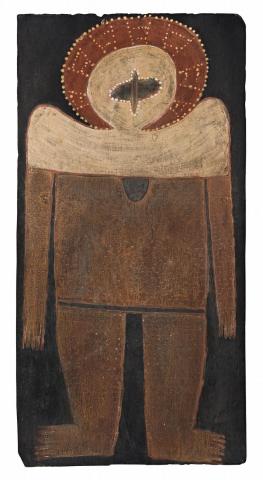WANJINA, c.1979
Attributed to ALEC MINGELMANGANU
natural earth pigments on engraved and pecked slate roof tile
51.5 x 26.5 cm
inscribed verso: McAlpine cat. 1433
Executed c.1980
The Lord Alistair McAlpine Collection, Broome
Purchased from The Pearl Coast Zoo, Broome c.1984
Private collection, Melbourne
Executed on slate, this rare and beautiful work attributed to Alec Mingelmanganu is a striking example of a Wanjina being. Representing the spirit ancestors of the north-west Kimberley peoples, Wanjina created the laws of social behaviour and are associated with the life-giving properties of water, bringing the monsoonal rains and distributing the spirits of the unborn to their clan waterholes. With their forms pre-determined by mythological precedent, Wanjina such as that shown here are executed in both red and white pigments to represent that ‘their bodies are partly filled with blood, partly with water.’1 Said to have emerged from the clouds, the beings’ bodies are typically rendered devoid of anatomical detail, the length of the torso delineated by the band around the waist which indicates a hair belt and the black oval shape upon the chest which is said to denote a breast bone.
At the time that this work was executed, Mingelmanganu had accompanied Ian Crawford on a trip to Lawley River where he saw depictions of Wanjina with high pointed shoulders. As shown in this example, the effect of the trip was immediate and in Mingelmanganu’s exhibition of 1980 at Aboriginal Traditional Arts in Perth, the work was dominated by figures of the same structure. Mingelmanganu is capable of imagery of great intensity, it was noted by Judith Ryan and Kim Akerman that ‘unique to the artist is his sense of proportion, the completeness of each composition and the use of a dark ground which serves to heighten and intensify the image of the Wandjina.’2
1. Schulz, Memoirs of the National Museum of Victoria, Melbourne, 1956, p. 9
2. ‘Shadows of Wandjina: Figurative Art of the North-west and Central Kimberley’ in Ryan, J., Images of Power, Aboriginal Art of the Kimberley, National Gallery of Victoria, Melbourne, p. 17
MERRYN SCHRIEVER
